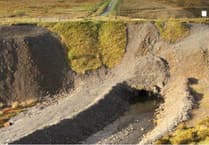Welsh farmers could soon have the option to breed sheep with a naturally low carbon footprint thanks to a new Farming Connect project with ambition to create an estimated breeding value (EBV) for methane yield.
Emissions from lambs in flocks involved in Farming Connect’s Welsh Sheep Genetics Project are being measured with portable accumulation chambers.
It is just one element of several linked to genetics that the programme will investigate over the next two years to help farmers strengthen flock performance, improve productivity and increase profitability, but an important one, says Heledd Dancer, Farming Connect’s sheep genetics officer for mid Wales, as it will give farmers the opportunity to select animals which genetically produce less methane.
This will help farmers assess and change their breeding programme and system to select sheep with lower methane emissions, enabling them to lower the carbon footprint of their flock and farm as well as contributing as an industry to reducing the overall environmental impact of methane emissions.
“We are giving farmers the unique opportunity to develop this EBV with us,” said Heledd.
“We know that sheep produce methane and we know there is a relationship between factors like gut size, so the intention is to figure out which animals in their flock can contribute to reducing methane emissions.”
The chambers allow measurements to be taken from up to 12 sheep at a time – this will be done by Aberystwyth-based Innovis, who is working in conjunction with Farming Connect on this project; to allow for consistency, those sheep will be kept on the same grazing regime for the previous three weeks.
As methane yield is a heritable trait, measurements will be taken from lambs that have been produced by a variety of sires.
The project aims to take measurements from over 1000 lambs over a two-year period.
Gwawr Williams, head of sheep genetics at Farming Connect, said this number is sufficient to develop a usable EBV for methane yield.
“It would also be sufficient to give us a good estimate of heritability within the population, for which we usually consider 900 to 1,000 animals to be the minimum,” she said.
There is good evidence that sheep with lower methane yields have a lower reticulorumen volume therefore the project will also utilise CT scanning to obtain accurate measures of reticulorumen dimensions in the live animal.
“It is vital that we understand changes in reticulorumen volume that may be associated with breeding sheep with a lower methane yield so that we can ensure there are no unintended consequences in terms of the sheep’s ability to utilise low quality forages,” said Gwawr.
There are now over 100 flocks involved in the Welsh Sheep Genetics Programme within two tiers, which also includes flocks which transitioned over from Hybu Cig Cymru’s Hill Ram Scheme.
Tier 1 is specific to hill and upland breeds while Tier 2 is for maternal breeds including the Blue Faced Leicester, Lleyn, Romney and Charmoise Hill.




